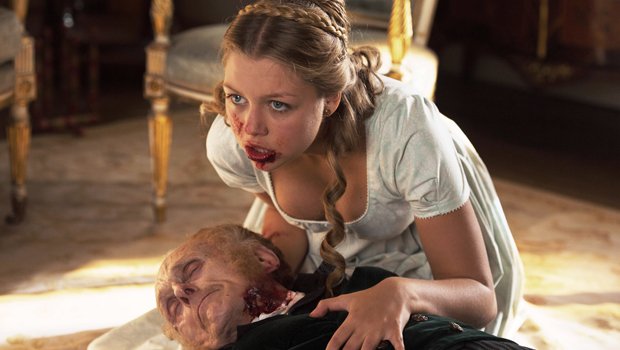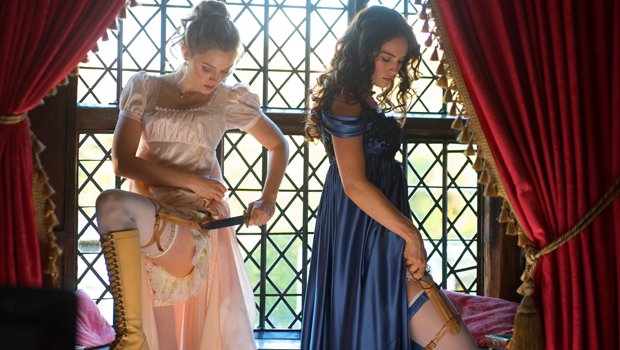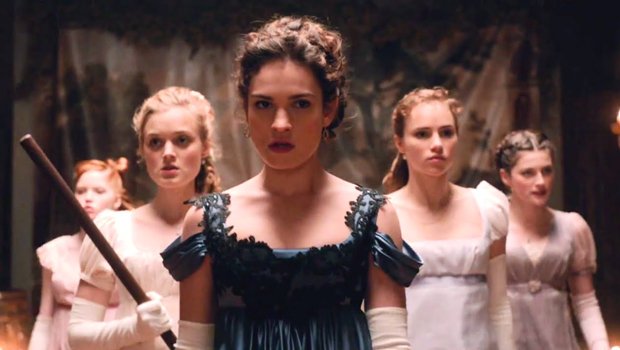Gore, guns and kick-ass heroines - on the set of Pride and Prejudice and Zombies
It’s a freezing December day in deepest, darkest Basingstoke. Ten minutes outside the Hampshire town, a large cast of extras in Regency attire are milling around a large farmhouse and barn. At first glance, you could be forgiven for thinking you’ve arrived on the set of yet another British costume drama. The sight of Lily James, wearing a purple dressing gown over her frilly costume to insulate her from the cold, only reinforces the idea.
Then comes the jaw-dropper as a new batch of extras shuffles past. Their flesh decaying, it can only mean one thing. Taken from the 2009 parody novel by Seth Grahame-Smith, a mash-up of Jane Austen’s seminal 1813 novel of manners and morality with the undead, it’s a period film like no other. Here, the zombies – dubbed the ‘unmentionables’ or the ‘manky dreadfuls’ – roam the English countryside after a pandemic struck 70 years earlier.

Given Grahame-Smith stated that Austen’s novel, with its militia camps from the Napoleonic wars in the backdrop, was “ripe for gore and senseless violence”, inserting a zombie plague is not as bizarre as it sounds. “It’s funny how different it makes you feel as an actor,” says James. “You’re trying to remember the tone of the film you’re in. While you’re doing this, it feels very Jane Austen-y. And then I’m very relieved when a zombie comes in!”
Starring as the fiercely independent Elizabeth Bennet, James admits it’s been a “battle” to marry Grahame-Smith’s high-concept with her traditional ideal of Austen’s heroine, as she searches for love. “Trying to maintain Liz in this new version with zombies [gives you] less time to focus on her as a character – and that’s hard,” she says. “I hope people aren’t like ‘What?’ She’s much fiercer and she’s a fighter and that takes precedence.”
James was uncertain when she first read the script. “I thought that either I will get through three pages and think ‘What a load of crap!’ Or that ‘Actually, this could be something.’” Fortunately, she stuck with it – despite the obvious risk involved. “Even being in it, so much of it will come down to Burr [Steers, the director] and how he puts all the pieces together.” What about the horror elements? “There’s an eeriness but a realness [to it],” she nods. “And the zombies look good. They’re scary.”

The American-born Steers, whose past films include 17 Again, knew exactly what he wanted. “Weirdly enough, I had a take when I went in, which was to re-insert Jane Austen and all the beats of the book,” he explains. “Other people went in very different directions with it, and my idea was to go back and think of it as you create this alternate world, where this zombie pandemic has happened, and then you’re staging Pride and Prejudice in it.”
As odd as it all sounds, placing zombies in 19th Century high society, Steers is insistent that the Austen characters treat this outbreak with the utmost seriousness, just as if it were typhoid or the black plague. “The thing was to play it not in a cheesy B-movie way but have you invested in the characters. It’s like when you take Richard III and put it in Nazi Germany.” A cartoon, then, it is not – even if the film promises to be filled with gore, guns and ass-kicking heroines.
Get sneak previews, exclusive competitions and details of special events each month!
Steers’s take on zombies was to have them as more “cognisant” than your average flesh-eater. “The idea would be that they’ve evolved, that they’ve been around for 70 years, that they’re coming to the point when they can actually strategise. Some of them are retaining more human qualities – who they were as human beings. One of the big influences for me, on this, was I Am Legend, Richard Matheson’s [1954] book; that idea that they’ve become a competing race… they don’t see themselves as the monsters.”

How Austen’s universe meshes with the zombies becomes clearer when Steers and James return to the set for the next take. James is joined by her ‘sisters’ – Bella Heathcote (as Jane Bennet), Suki Waterhouse (Kitty), Millie Brady (Mary) and Ellie Bamber (Lydia) – for a scene set around the town ball. Marching towards the camera, this quintet is perfectly choreographed, as they spin, kick and punch their way through the hoards of attacking zombies, with some impressive martial arts skills.
With the Bennet sisters said to have picked up their fighting moves in China, the chance to play female combatants is something all the girls relished. “I was so excited about getting bruises,” laughs Waterhouse, who also happens to be a brown belt in karate (she used to spar with her sister, growing up). “I did a fight with Lily and I got leg and arm bruises, and I literally didn’t want them to disappear. I loved it! I almost wanted to darken them!”
The conflicts, of course, aren’t just between the humans and the zombies. One of the smart aspects of the story is how Austen’s verbal jousts are given a physical edge. “The proposal scene with Liz Bennet is now a full on fight between the two of us – she attacks me with a letter opener!” laughs Sam Riley, who plays Mr. Darcy, the aloof gentleman protagonist of Austen’s novel, who here has been refashioned as a canny zombie hunter.

While Austen purists may be up in arms about such good-natured sacrilege, it’s not the first time she has been mashed into something else. English author P.D. James’s 2011 novel Death Comes to Pemberley was a sequel-of-sorts, set six years after events of Austen’s novel, turning the story into a murder-mystery. “The characters are great,” notes Steers, “you almost want to take them and see what else they can do.”
Admittedly, the last historical mash-up to hit screens, 2012’s Abraham Lincoln: Vampire Hunter, adapted by Grahame-Smith from his own novel, left a lot to be desired. But James makes a case that has plenty of relevance, citing the Ebola crisis that gripped parts of the world. “Not that I’m saying Ebola is like zombies. But [there is] this idea of something that infiltrates, this zombie bite – it’s uncontrollable and it takes over.”
Perhaps even more contentiously, Steers notes how we’re living in an age where radicalised kids “from suburban England” are joining terror groups. “You can’t look at somebody and tell if they’re on your side and that was one of the things that I was interested in. There are these people [in the film] born of the same backgrounds as the others and they’ve become infected and they’re passing as non-zombies – that was one of the things I was instilling.”

Steers admits he wasn’t initially steeped in zombie lore, though George Romero’s Night of the Living Dead was “interesting” to him. “That movie worked in so many ways – having a black lead, in a very racist era in America.” Much of his knowledge, he says, came from working on a piece about Haiti “and how they used all the lore and that’s where I initially got into it”.
Likewise, James admits that the undead weren’t exactly her thing growing up. “As a kid, I wondered if I had a good imagination because I wasn’t scared of zombies or monsters,” she notes. “I was just scared of kidnappers. I always thought a man would steal me from our car or my bedroom! But I do love zombies.”
Certainly, she’s learning fast. Back on the set, as she prepares for another take, the actress offers some sound advice for surviving the zombie apocalypse. “Have four bad-ass sisters to go with you wherever you go! Have a dagger in your boot and knickers! Have daggers hidden in your hair. Basically hide as much weaponry on you in as sexy manner as possible!” She smiles. “Oh, and kill every zombie twice.”
For more gruesome zombie action, pick up the definitive guide to the undead with Zombies: the ultimate celebration, on sale February 4, 2016.
Images: Pride and Prejudice and Zombies
James Mottram is a freelance film journalist, author of books that dive deep into films like Die Hard and Tenet, and a regular guest on the Total Film podcast. You'll find his writings on GamesRadar+ and Total Film, and in newspapers and magazines from across the world like The Times, The Independent, The i, Metro, The National, Marie Claire, and MindFood.


